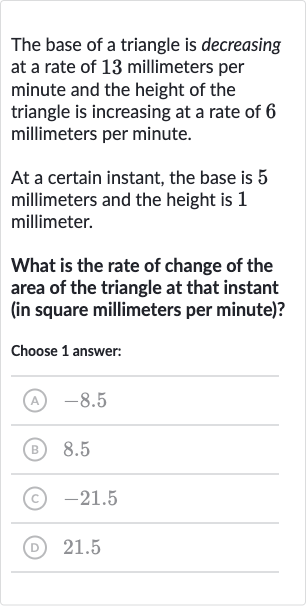AI tutor
Welcome to Bytelearn!
Let’s check out your problem:

The base of a triangle is decreasing at a rate of millimeters per minute and the height of the triangle is increasing at a rate of millimeters per minute.At a certain instant, the base is millimeters and the height is millimeter.What is the rate of change of the area of the triangle at that instant (in square millimeters per minute)?Choose answer:(A) .(B) .(C) .(D) .
Full solution
Q. The base of a triangle is decreasing at a rate of millimeters per minute and the height of the triangle is increasing at a rate of millimeters per minute.At a certain instant, the base is millimeters and the height is millimeter.What is the rate of change of the area of the triangle at that instant (in square millimeters per minute)?Choose answer:(A) .(B) .(C) .(D) .
- Area Formula: The area of a triangle is given by the formula .
- Derivative Calculation: Let's denote the base by and the height by . The rate of change of the area with respect to time can be found using the derivative .
- Given Rates: Given mm/min (since the base is decreasing) and mm/min (since the height is increasing).
- Instant Values: At the instant when the base is and the height is , we plug these values into the derivative formula to find .
- Calculate : So, .
- Final Result: Calculating the above expression gives .
- Final Result: Calculating the above expression gives . square millimeters per minute.
